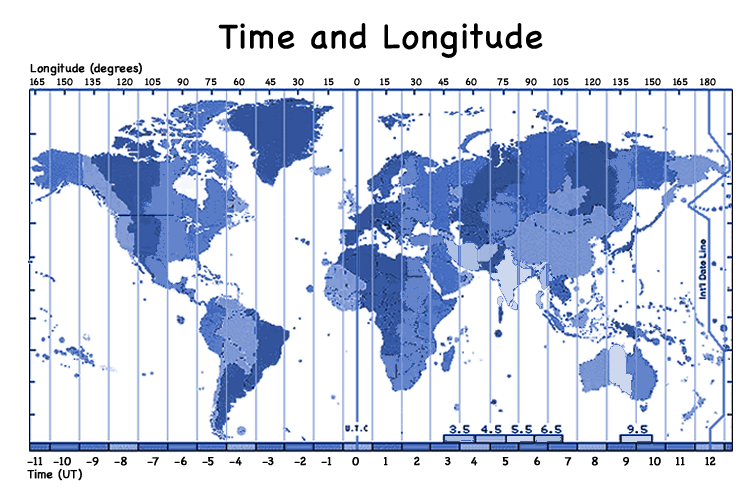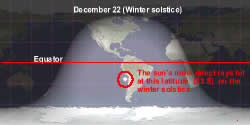Glossary
|
Axis
of the Earth An imaginary straight line running through the center of the Earth from the North Pole to the South Pole. The earth is said to rotate (spin) on this axis, which is "tilted" in relation to the sun. This causes our seasons. |
|
| Day Length
Also known as photoperiod. The length of time between sunrise and sunset. |
|
| Equinox The word means "equal night." It refers to the two moments each year when the sun appears to cross the equator. The spring (vernal) equinox is around March 21 and the fall (autumnal) equinox is around September 23. Almost all places on Earth have about 12 hours of daylight and 12 hours of night on the equinoxes. The sun doesn't really move, but it looks like it does to us. That's because our Earth is tilted as it revolves around the sun once a year. |
 Spring or fall equinox |
|
Greenwich
Mean Time (GMT) |
 This map shows how many hours you need to add to or subtract from your local time to get the GMT. (Click to enlarge.) |
| Hemisphere A mapping division meaning half of the Earth (sphere). First, picture cutting the earth in half at the equator (0 degrees latitude). This divides the Earth into the Northern Hemisphere (north of the equator) and the Southern Hemisphere (south of the equator). These are labeled in yellow on the illustration. Next picture cutting the earth in half at the Prime Meridian (0 degrees longitude). This divides the Earth into the Western Hemisphere (west of the Prime Meridian) and the Eastern Hemisphere (east of the Prime Meridian). These are labeled in red on the illustration. |
 Click to enlarge this image of the earth's hemispheres. |
| Latitude Imaginary horizontal mapping lines on the Earth. They are known as "parallels" of latitude because they run parallel to the Equator. The number of degrees of latitude shows how far north or south of the Equator a specific location is. |
 |
| Longitude |
 |
|
Meridian
An imaginary line that runs vertically, north and south, from the North Pole to the South Pole. All points on a meridian have the same longitude. |
|
|
Photoperiod Also called day length. The length of time between sunrise and sunset. |
|
| Revolution
of the Earth The yearly 365 1/4 days trip the Earth takes around the sun. We experience different seasons as the tilted Earth revolves around the sun. |
 |
|
Rotation
of the Earth The spinning or turning of the earth on its axis. The Earth makes one complete rotation every twenty-four hours. |
|
| Solstice The word means "sun stop." It refers to the two moments each year when the sun appears to be farthest from the equator. On the winter solstice in our hemisphere (around December 22), the sun seems to reach its most southerly point. It is our shortest day of the year. From there, it seems to head north until it reaches its most northerly point. That is our summer solstice (around June 21): the longest day of the year. When the Northern Hemisphere has its summer solstice, the Southern Hemisphere has its winter solstice, and vice versa.The sun doesn't really move, but it looks like it does to us. That's because our Earth is tilted as it revolves around the sun once a year. |
 Winter Solstice in the Northern Hemisphere 
Summer Solstice in the Northern Hemisphere |
| Twenty-Four
Hour Clock Instead of keeping time on the basis of 12 a.m. hours and 12 p.m. hours, the 24-hour clock runs straight through. It begins at 00:00 (midnight) and runs to 23:59 (11:59 PM). This is also known as "military time." |
 |



